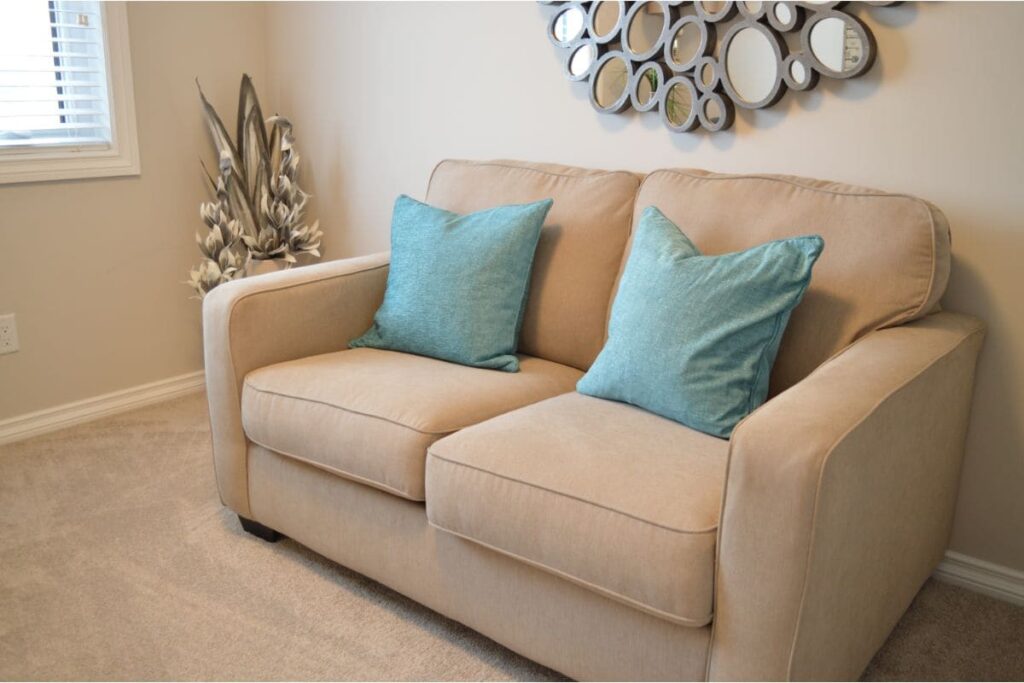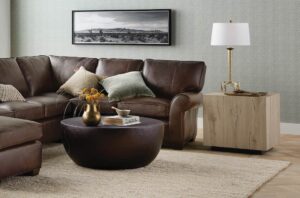West Elm vs CB2 are household names when it comes to high-end home furnishings. But choosing between them can leave customers scratching their heads. Both brands promise quality and style but differ in key areas that can significantly impact your purchasing decision.
Our article aims to clear the fog by dissecting what each brand brings to the table, from their origins and product offerings to customer satisfaction and sustainability practices.
Stick around to gain insightful data that will guide you in making an informed choice between these two top-tier furniture companies.
Company Backgrounds and Market Presence
Understanding the roots and market reach of West Elm vs CB2 can offer valuable insights into what sets them apart. This section sheds light on the evolution of both brands, their parent companies’ roles, and the geographical areas they serve.
Origin and Growth of West Elm
West Elm sprang onto the scene in 2002 as a subsidiary of the Williams-Sonoma group, which also owns Pottery Barn. Over the years, the brand has distinguished itself with modern designs and a strong focus on sustainability. Today, about 60% of West Elm’s products support at least one eco-friendly initiative, and 35% of their wood furniture comes with FSC certification.
Origin and Growth of CB2
Contrastingly, CB2 is a younger offshoot of Crate & Barrel, founded in 1962. CB2 aims to offer modern furniture tailored for smaller living spaces like lofts, apartments, and houses. The brand positions itself as a provider of quality furniture at varied price points, appealing to a broad demographic.
Note: CB2 and Crate & Barrel, despite having similar roots, cater to different market segments with distinct design philosophies.
Parent Companies and Their Influence
- West Elm: Williams-Sonoma, its parent company, lends its reputation for quality and customer service to West Elm, enhancing the brand’s credibility.
- CB2: Owned by Crate & Barrel, CB2 benefits from years of industry experience and a strong focus on customer satisfaction.
Geographical Availability
Both West Elm and CB2 have made their mark in North America.
- West Elm: Available both online and in physical stores across the United States and Canada.
- CB2: Offers showrooms and online shopping, with free in-home delivery within 7 to 10 business days in the United States.
By knowing more about each brand’s history and market presence, you can better gauge which aligns with your specific needs and preferences.
Read Also: Bassett vs Flexsteel – What Should You Choose?
Product Offerings and Design Philosophy
A critical aspect of selecting furniture and home decor is aligning the product offerings with your individual tastes and needs. West Elm vs CB2 have unique design philosophies that influence their product lines. Let’s delve into the core principles that guide each brand and assess their range of products and customizable options.
Core Design Principles of West Elm
West Elm emphasizes modern designs featuring clean lines, bold colors, and unique textures. Sustainability is also a significant factor in their design process. For instance, 60% of their products have at least one eco-friendly attribute, such as the use of FSC-certified wood, organic cotton, and recycled materials.
Core Design Principles of CB2
CB2, on the other hand, focuses on modern furniture suited for lofts, apartments, and houses. The brand is committed to quality and offers furniture at different price points, aiming to appeal to a wide demographic.
Note: Although both brands prioritize modern design, West Elm places a more substantial emphasis on sustainability.
Range of Home Furnishings and Decor
| Category | West Elm | CB2 |
|---|---|---|
| Furniture | Sofas, tables, beds | Sofas, tables, beds |
| Decor | Artwork, rugs, lighting | Lighting, rugs, mirrors |
| Kitchen & Dining | Dishware, utensils | Glassware, utensils |
Customizable Options Available
- West Elm: Offers a 3D room planner tool for better visualization, and free design services including virtual consultations.
- CB2: While not offering the same level of customization as West Elm, CB2 does provide varied choices for different budgets, including various couch types like sofas, sectionals, sleeper sofas, and more.
Understanding these attributes can help you make an informed decision tailored to your personal needs, be it aesthetic harmony, functionality, or a harmonious blend of both.
Quality of Products and Customer Feedback
Assessing product quality and customer feedback is indispensable for any consumer contemplating a significant purchase. In this respect, West Elm or CB2 both have unique strengths and challenges, as perceived by their customer base. Let us look into the materials that each brand uses in its products and gauge general customer satisfaction.
Materials Used by West Elm
West Elm prioritizes sustainability in its product materials. From FSC-certified wood to recycled polyester, the brand goes the extra mile to ensure environmental responsibility. Additionally, West Elm frequently uses organic cotton in its textiles.
Note: The use of sustainable materials is a distinguishing feature for West Elm.
Materials Used by CB2
CB2 is also committed to quality but leans more toward durability and aesthetic appeal. You’ll often find products made from engineered wood, metal, and high-quality fabrics. However, the focus on sustainability is notably less compared to West Elm.
General Customer Satisfaction with West Elm
Reviews generally praise West Elm for its aesthetic appeal and environmental responsibility. However, some customers have raised concerns about product longevity and customer service responsiveness.
General Customer Satisfaction with CB2
CB2 receives high marks for its diverse product range suitable for various budgets. Their products are often described as durable and long-lasting, which appears to be a significant factor in customer satisfaction.
| Brand | Material Focus | Customer Satisfaction |
|---|---|---|
| West Elm | Sustainability | Mixed reviews |
| CB2 | Durability, Aesthetics | Generally positive |
By understanding the materials used and scrutinizing customer feedback, prospective buyers can make a well-informed choice between West Elm and CB2.
Pricing and Payment Options
A major consideration for consumers when evaluating West Elm vs CB2 is, undoubtedly, the cost. Price points and payment options vary between the two brands, often influencing a customer’s ultimate choice. Below, we detail the pricing range, affordability, and financing options offered by each.
Price Range and Affordability of West Elm Products
West Elm positions itself in the mid to high-end market. Here, consumers can expect to pay a premium for sustainability and unique designs. For example, sofas typically range from $800 to $3,000.
Note: Discounts and sales are more frequent during holiday seasons, offering opportunities for more budget-friendly purchases.
Price Range and Affordability of CB2 Products
CB2 offers a more varied pricing strategy, accommodating both budget-conscious and high-end customers. Its sofas, for instance, can range from as low as $600 to upwards of $2,500.
Financing Options in West Elm
West Elm provides multiple financing options, including installment plans and a branded credit card with special financing terms. It’s important to note that a good credit score is often necessary to avail these options.
Financing Options in CB2
CB2 also extends credit facilities to its customers, including a store-specific credit card. However, it offers fewer installment plans compared to West Elm.
| Brand | Pricing Range | Financing Options |
|---|---|---|
| West Elm | Mid to High-End | Multiple, Credit-dependent |
| CB2 | Wide Range | Store Card, Fewer Installment Plans |
The options available in pricing and financing can significantly affect a customer’s choice between West Elm and CB2. Both brands offer flexibility, albeit in different respects.
Shipping, Delivery, and Assembly
The process from purchase to product placement at home often hinges on shipping, delivery, and assembly. With this in mind, a side-by-side comparison between West Elm and CB2 in these areas can offer further clarity for consumers. Below, we elucidate the nuances of shipping variabilities and assembly services for both brands.
West Elm Shipping Variabilities
West Elm generally offers standard, deluxe, and white-glove shipping options. The latter includes in-home delivery and setup. Costs vary by item size and destination.
Note: West Elm sometimes offers free shipping promotions, but these are often limited to smaller items.
CB2 Shipping Variabilities
Unlike West Elm, CB2 focuses more on flat-rate shipping, which can make it easier to estimate costs. For larger items like furniture, a separate freight charge applies.
Assembly Services Offered by West Elm
West Elm’s white-glove service includes assembly, making it a one-stop solution for busy individuals. This service, however, comes at a premium and isn’t available for all items.
Assembly Services Offered by CB2
CB2, on the other hand, generally charges separately for assembly. They do offer it as an add-on for most furniture pieces, but it is usually not included in the initial price or shipping cost.
| Brands | Shipping Options | Assembly Service Included? |
|---|---|---|
| West Elm | Standard, Deluxe, White-Glove | White-Glove Service Only |
| CB2 | Flat-Rate, Freight for Large Items | As a Separate Charge |
Considering shipping and assembly can influence a customer’s experience and final decision between West Elm and CB2. Both brands have their merits and drawbacks in this regard.
Sustainability Initiatives
Environmental responsibility is more than a buzzword—it is a commitment to the future. When it comes to home furnishing, consumers are increasingly seeking out brands that uphold sustainability principles. Here, we’ll compare the green initiatives undertaken by West Elm vs CB2, offering valuable information on their environmental practices, certifications, and community partnerships.
Environmental Practices of West Elm
West Elm has been proactive in using sustainable materials for their products. They use FSC-certified wood for a significant portion of their furniture line and have a well-established recycling program. Organic cotton and reclaimed materials feature prominently in their offerings.
Note: West Elm has committed to making 40% of their product assortment sustainably sourced by a set date.
Environmental Practices of CB2
CB2, though perhaps less heralded for its green initiatives, is making strides in this area. The brand utilizes eco-friendly packaging and offers a selection of items made from recycled or sustainable materials.
Certifications and Endorsements
Both brands have received accolades for their environmental initiatives. West Elm has been awarded numerous sustainability certifications, including Fair Trade and FSC. CB2, while not as extensively certified, has been making steps to obtain more verifiable sustainability credentials.
Community and Artisan Partnerships
West Elm stands out for its partnerships with local artisans and its commitment to fair trade and ethical labor practices. CB2 is also involved in community projects but focuses more on collaborations with established designers to create unique, limited-edition pieces.
| Brands | Sustainable Material Use | Certifications | Community Partnerships |
|---|---|---|---|
| West Elm | FSC-certified Wood, Organic Cotton | Fair Trade, FSC | Local Artisans, Fair Trade |
| CB2 | Recycled Materials, Eco-friendly Packaging | In Progress | Established Designers |
As sustainability remains a focal point for the conscientious consumer, understanding how West Elm and CB2 are contributing to environmental preservation can influence purchasing decisions. Both brands are indeed making an effort, albeit with differing focuses and achievements.
Read Also: Bassett vs La-Z-Boy – Which Should You Choose?
Conclusion
This analysis of West Elm vs CB2 has presented various dimensions—ranging from product quality to sustainability efforts. The ultimate choice may come down to individual preferences and needs.
West Elm excels in sustainability and artisan collaborations, while CB2 shines in its modern design ethos and pricing flexibility.
For eco-conscious consumers, West Elm would be more aligned with their values. If design and affordability take precedence, CB2 might be the more fitting choice.
Both West Elm and CB2 offer something unique to the home furnishing market. Neither is objectively superior; rather, they cater to different consumer priorities.
West Elm is likely to further cement its sustainability initiatives, while CB2 may focus on expanding its design partnerships and material options. Keep an eye on both as they continue to evolve in the market.





